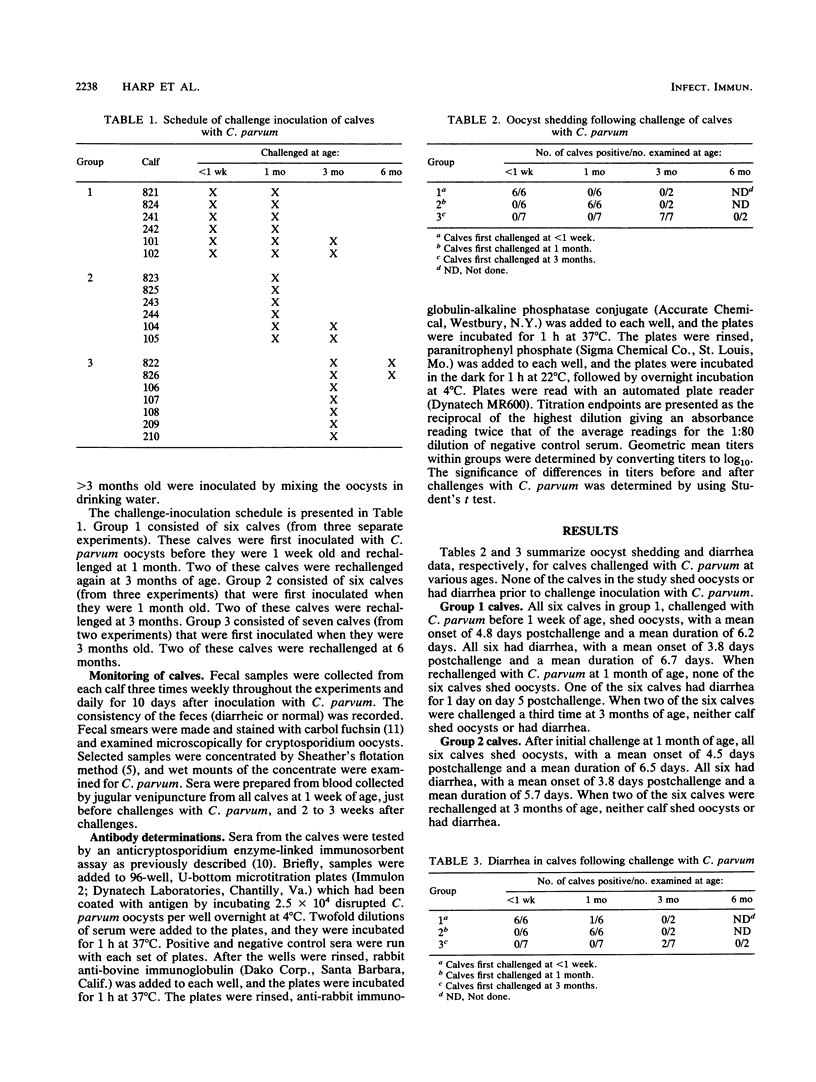Abstract
Cryptosporidium parvum is a coccidian parasite that causes diarrheal disease in many vertebrate species, including young (less than or equal to 1 month old) calves. Older calves and adult cattle are resistant to infection. In this study, newborn calves were raised in isolation from C. parvum for 1 week to 3 months before experimental challenge with the parasite. Calves orally challenged with C. parvum at 1 week of age shed oocysts in their feces and had diarrhea after challenge exposure. When these calves were rechallenged at 1 and 3 months of age, they neither shed oocysts nor had diarrhea. There was no significant increase in the mean anticryptosporidium enzyme-linked immunosorbent assay serum antibody titer in these calves following any of the challenge exposures. Calves orally inoculated with C. parvum for the first time at 1 month of age shed oocysts, had diarrhea after challenge exposure, and were resistant to rechallenge at 3 months of age. These calves had a twofold increase in serum antibody titer after the first challenge and no increase after the second challenge. Calves orally inoculated with C. parvum for the first time at 3 months of age shed oocysts, and two of seven animals had diarrhea. These calves had a 10-fold increase in serum antibody to C. parvum after exposure. This study demonstrates that calves raised in isolation from C. parvum remain susceptible to challenge until at least 3 months of age. Furthermore, within this time period, initial exposure and recovery renders calves resistant to further challenge with the parasite. The data also suggest that exposure of young calves to C. parvum may inhibit the development of a serum antibody response to the parasite.
Full text
PDF



Selected References
These references are in PubMed. This may not be the complete list of references from this article.
- Arrowood M. J., Mead J. R., Mahrt J. L., Sterling C. R. Effects of immune colostrum and orally administered antisporozoite monoclonal antibodies on the outcome of Cryptosporidium parvum infections in neonatal mice. Infect Immun. 1989 Aug;57(8):2283–2288. doi: 10.1128/iai.57.8.2283-2288.1989. [DOI] [PMC free article] [PubMed] [Google Scholar]
- Campbell P. N., Current W. L. Demonstration of serum antibodies to Cryptosporidium sp. in normal and immunodeficient humans with confirmed infections. J Clin Microbiol. 1983 Jul;18(1):165–169. doi: 10.1128/jcm.18.1.165-169.1983. [DOI] [PMC free article] [PubMed] [Google Scholar]
- Casemore D. P., Sands R. L., Curry A. Cryptosporidium species a "new" human pathogen. J Clin Pathol. 1985 Dec;38(12):1321–1336. doi: 10.1136/jcp.38.12.1321. [DOI] [PMC free article] [PubMed] [Google Scholar]
- Current W. L. Cryptosporidiosis. J Am Vet Med Assoc. 1985 Dec 15;187(12):1334–1338. [PubMed] [Google Scholar]
- Current W. L., Reese N. C., Ernst J. V., Bailey W. S., Heyman M. B., Weinstein W. M. Human cryptosporidiosis in immunocompetent and immunodeficient persons. Studies of an outbreak and experimental transmission. N Engl J Med. 1983 May 26;308(21):1252–1257. doi: 10.1056/NEJM198305263082102. [DOI] [PubMed] [Google Scholar]
- Davis C. P., McAllister J. S., Savage D. C. Microbial colonization of the intestinal epithelium in suckling mice. Infect Immun. 1973 Apr;7(4):666–672. doi: 10.1128/iai.7.4.666-672.1973. [DOI] [PMC free article] [PubMed] [Google Scholar]
- Ernest J. A., Blagburn B. L., Lindsay D. S., Current W. L. Infection dynamics of Cryptosporidium parvum (Apicomplexa: Cryptosporiidae) in neonatal mice (Mus musculus). J Parasitol. 1986 Oct;72(5):796–798. [PubMed] [Google Scholar]
- Fayer R., Ungar B. L. Cryptosporidium spp. and cryptosporidiosis. Microbiol Rev. 1986 Dec;50(4):458–483. doi: 10.1128/mr.50.4.458-483.1986. [DOI] [PMC free article] [PubMed] [Google Scholar]
- Harp J. A., Wannemuehler M. W., Woodmansee D. B., Moon H. W. Susceptibility of germfree or antibiotic-treated adult mice to Cryptosporidium parvum. Infect Immun. 1988 Aug;56(8):2006–2010. doi: 10.1128/iai.56.8.2006-2010.1988. [DOI] [PMC free article] [PubMed] [Google Scholar]
- Harp J. A., Woodmansee D. B., Moon H. W. Effects of colostral antibody on susceptibility of calves to Cryptosporidium parvum infection. Am J Vet Res. 1989 Dec;50(12):2117–2119. [PubMed] [Google Scholar]
- Heine J. Eine einfache Nachweismethode für Kryptosporidien im Kot. Zentralbl Veterinarmed B. 1982 May;29(4):324–327. [PubMed] [Google Scholar]
- Heine J., Moon H. W., Woodmansee D. B. Persistent Cryptosporidium infection in congenitally athymic (nude) mice. Infect Immun. 1984 Mar;43(3):856–859. doi: 10.1128/iai.43.3.856-859.1984. [DOI] [PMC free article] [PubMed] [Google Scholar]
- Moon H. W., Woodmansee D. B. Cryptosporidiosis. J Am Vet Med Assoc. 1986 Sep 15;189(6):643–646. [PubMed] [Google Scholar]
- Moon H. W., Woodmansee D. B., Harp J. A., Abel S., Ungar B. L. Lacteal immunity to enteric cryptosporidiosis in mice: immune dams do not protect their suckling pups. Infect Immun. 1988 Mar;56(3):649–653. doi: 10.1128/iai.56.3.649-653.1988. [DOI] [PMC free article] [PubMed] [Google Scholar]
- Navin T. R., Juranek D. D. Cryptosporidiosis: clinical, epidemiologic, and parasitologic review. Rev Infect Dis. 1984 May-Jun;6(3):313–327. doi: 10.1093/clinids/6.3.313. [DOI] [PubMed] [Google Scholar]
- Savage D. C., Dubos R., Schaedler R. W. The gastrointestinal epithelium and its autochthonous bacterial flora. J Exp Med. 1968 Jan 1;127(1):67–76. doi: 10.1084/jem.127.1.67. [DOI] [PMC free article] [PubMed] [Google Scholar]
- Sherwood D., Angus K. W., Snodgrass D. R., Tzipori S. Experimental cryptosporidiosis in laboratory mice. Infect Immun. 1982 Nov;38(2):471–475. doi: 10.1128/iai.38.2.471-475.1982. [DOI] [PMC free article] [PubMed] [Google Scholar]
- Soave R., Armstrong D. Cryptosporidium and cryptosporidiosis. Rev Infect Dis. 1986 Nov-Dec;8(6):1012–1023. doi: 10.1093/clinids/8.6.1012. [DOI] [PubMed] [Google Scholar]
- Tomasi T. B., Jr, Larson L., Challacombe S., McNabb P. Mucosal immunity: The origin and migration patterns of cells in the secretory system. J Allergy Clin Immunol. 1980 Jan;65(1):12–19. doi: 10.1016/0091-6749(80)90171-2. [DOI] [PubMed] [Google Scholar]
- Tzipori S. Cryptosporidiosis in animals and humans. Microbiol Rev. 1983 Mar;47(1):84–96. doi: 10.1128/mr.47.1.84-96.1983. [DOI] [PMC free article] [PubMed] [Google Scholar]
- Ungar B. L., Soave R., Fayer R., Nash T. E. Enzyme immunoassay detection of immunoglobulin M and G antibodies to Cryptosporidium in immunocompetent and immunocompromised persons. J Infect Dis. 1986 Mar;153(3):570–578. doi: 10.1093/infdis/153.3.570. [DOI] [PubMed] [Google Scholar]


